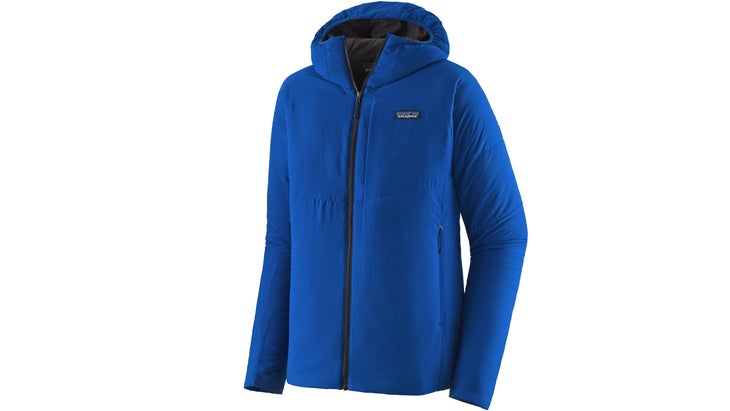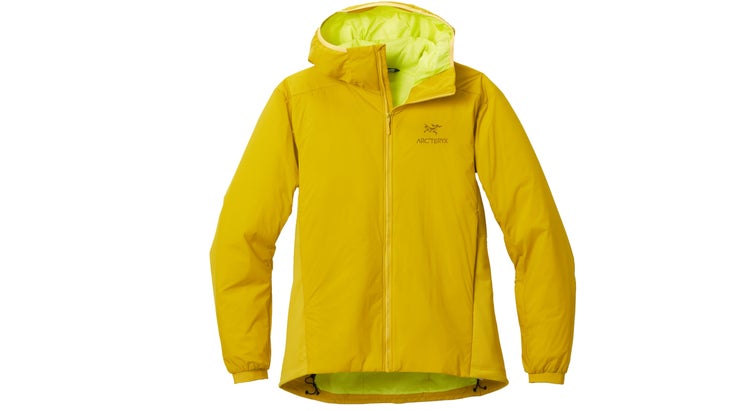Products You May Like
The breathable, active insulator might be one of the most important jackets in your gear closet. On summer nights, it’s a puffy for taking the chill off. On cooler winter days, it’s an active piece to wear in the skin track or on the trail. And on the coldest days, it layers easily under your parka. For that reason, there’s no shortage of them, all with different insulation technologies, temperature ranges, water or windproofing abilities, zipper lengths, hoods, and more.
But two true stalwarts of the category—the Patagonia Nano-Air Hoody and the Arc’teryx Atom LT Hoody—have sat at the top of their class for the better part of a decade. On first glance, these two alpine-focused full-zip mid layers look like clones of one another: lightweight synthetic insulators lauded for—and excelling at—breathability. But in reality, they each fill a unique niche for different users.
So which one is best for you? Let’s break it down.

Patagonia Nano-Air Hoody
$299; 12.2 oz.; Buy Now
The goal for this category of jacket is to be able to put it on before you leave camp and keep it on when you start skinning uphill, limiting the number of stops you need to make to switch up your layers. The Nano-Air and Atom take slightly different avenues to achieve that balance of breathability and warmth. Patagonia uses 60 grams of the brand’s proprietary FullRange polyester insulation. It’s warm, stretchy, and supremely breathable, and it extends through the entire jacket. It’s held together with an even more stretchy and breathable polyester face fabric, which is soft and super comfortable, but not exceedingly durable—you might not want to bushwhack in this jacket. Downside: All that breathability means the Nano Air isn’t very good at cutting wind, though it does have a DWR coating capable of handling very light rain or snow.
This is a piece that excels in full-on winter conditions. The full-body insulation sets the Nano-Air apart as a superb cold-weather layer, designed for skiing, mountaineering, and hiking on especially chilly days. We’ve tested the jacket everywhere from snowy ridgelines in the Alaska Range (where cloudy skies kept the temps in the high single digits) to cold ski tours in Montana’s Gallatin Range. Midwinter ski tours in Colorado when temps rose as high as the upper 20s and the sun was blazing, though, proved too warm for one of our hot-blooded testers. Price note: The Nano-Air is $40 more expensive than the Atom.
The jacket has two hand pockets in front, and a chest pocket which doubles as a stuff sack, packing the jacket down to just smaller than a football (though you could easily get it smaller), as well as a helmet-compatible hood.
You’ll want the Nano-Air if you:
- Are a cold-blooded skier or climber looking for a slightly warmer jacket
- Are recreating primarily in very cold climates
- Doing slower-paced, low elevation mountaineering
- Need an extremely packable active insulation layer

Arc’teryx Atom LT Hoody
$259; 13.2 oz.; Buy Now
The Atom uses Arc’teryx’s own Coreloft Compact insulation—also in a 60 gram weight—plus a similar stretchy, durable synthetic face fabric to keep wearers warm. The biggest difference, though, is that Arc’teryx swapped out Coreloft under the arms and down the sides with stretchy fleece. That makes the Atom more comfortable at higher temperatures, becoming one tester’s go-to while touring in temperatures as high as the mid 30s and as cold as the low 20s. Another tester, who tends to run a little warmer, was just fine in even colder temps.
One ding: Those panels didn’t dry out as quickly as the Coreloft body insulation when they got a little sweaty, which kept things a bit damp on big days. But for the most part, the Atom handles sweat well and stays comfortable. The nylon Tyono face fabric is similarly soft and nearly as fragile as Patagonia’s, but the fleece sides are definitely more durable when rubbing against pack straps.
The Atom also features a helmet-compatible hood (which, unlike the Nano-Air, has an adjustable cinch in the back) two hand pockets, and an internal chest pocket. The Atom is also slightly heavier and bulkier than the Nano Air, likely thanks to the fleece, which isn’t nearly as compressible as the lofted insulation. The difference is minor but noticeable, especially considering that the Atom doesn’t pack into its own pocket. The Atom also has a little more stretchy material around the cuffs and an adjustable cinch at the hem (the Nano Air’s isn’t adjustable) which helps seal out wind or snow. Other than that, the Atom’s wind cutting and precip-blocking chops are comparable to the Nano-Air.
Consider the Atom LT if you:
- Run a bit warmer while ski touring or climbing
- Want a jacket for higher-intensity activities
- Recreate primarily in warmer winter climates
- Want more durability when wearing winter packs
